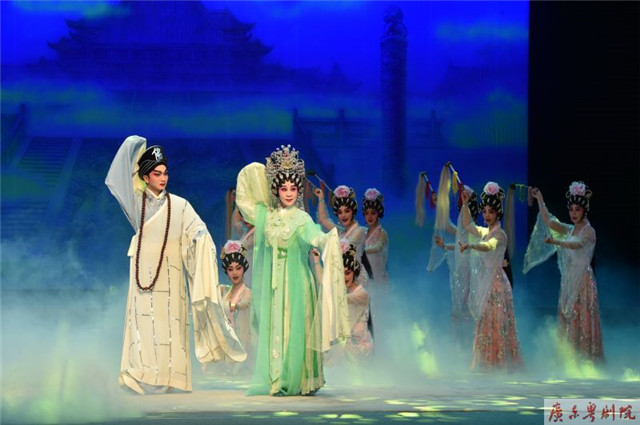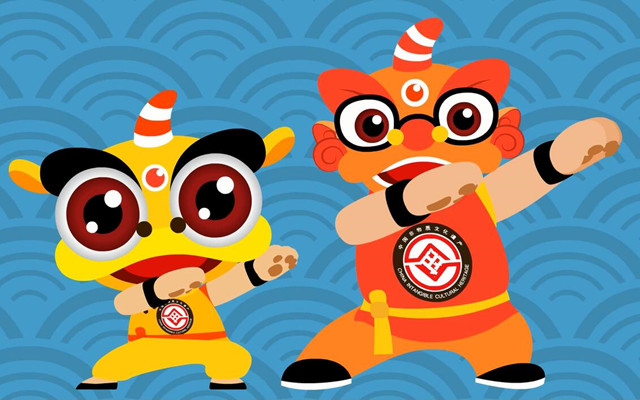June 8th marks China's third Cultural and Natural Heritage Day. Organized by the Ministry of Culture and Tourism, the festival will be held between June 7th and 10th across China, and the national main venue of this year’s event is Guangzhou.
Organised around China’s 40 UNESCO listed cultural heritages, this year’s festival consists of a series of activities, including an opening ceremony, stage performances, an exhibition, and forums.
A stage photo of a Cantonese opera [Photo: Guangdong Cantonese Opera Troupe]
The stage performances will be held at the Guangzhou Baiyun International Convention Center on the evenings of June 7th and 8th, presenting forty of China’s cultural practices and expressions of intangible heritage as now recorded by UNESCO. This is the first time that all 40 inscribed elements will be showcased at the same time. China’s first element Kun Qu opera was inscribed on the UNESCO's Representative List of the Intangible Cultural Heritage of Humanity in 2008.
The exhibition will be held at the Guangzhou Urban Planning Exhibition Center from June 8th to 10th, featuring photos and videos demonstrating the 40 elements. You can make an appointment to visit the exhibition via the Center’s official WeChat account “广州市城市规划展览中心” or call 020-83520680.
Cultural heritage themed forums will also take place at the Center on June 8th and be attended by experts and scholars from Tsinghua University, the Chinese National Academy of Arts and Shanghai Academy of Social Sciences. They will discuss the concepts, practice and experience related to heritage protection in China.
Guangzhou in particular will hold a series of activities to celebrate the 10th anniversary of Cantonese opera being inscribed on UNESCO list, to mark the Dragon Boat Festival, and to allow people to get involved. All activities will be open to the public for free.
There will be an accompanying publication which includes special reports, expert interviews, and information regarding events and exhibitions on the theme of cultural heritage.
A screenshot of “Feifei” and “Xingxing”. [Photo: Guangdong Provincial Department of Culture and Tourism]
The mascots, which have been designed for the event, are named “Feifei” and “Xingxing”. Inspired by the Lion Dance, two animated lions have been designed to cultivate the younger generation’s enthusiasm for maintaining cultural heritage. During the event, “Feifei” and “Xingxing” will interact the audience in the exhibition and performance sections.
The event will also feature a special souvenir ticket is a traditional Cantonese paper cut.
Finally the event will feature an inspiring theme song, which will be played For the first time at the end of stage performance.
About the Cultural and Natural Heritage Day
The Cultural and Natural Heritage Day, whose name was changed in 2016 by the State Council from the former Cultural Heritage Day, is held on the second Saturday of every June. It is a collective showcase of achievements on intangible cultural heritage protection.
China now has 40 inscribed elements in total on relevant UNESCO lists, including 32 elements inscribed on the Representative List of the Intangible Cultural Heritage of Humanity, 7 elements inscribed on the List of Intangible Cultural Heritage in Need of Urgent Safeguarding, and one program selected to the Register of Good Safeguarding Practices.
Authors: Monica Liu, Li Jiaxing
Editor: Simon Haywood

Photo taken on Nov. 21, 2018 shows the herbs of Lum medicinal bathing of Sowa Rigpa in southwest China's Tibet Autonomous Region. The United Nations Educational, Scientific and Cultural Organization (UNESCO) inscribed China's Lum medicinal bathing of Sowa Rigpa on the Representative List of the Intangible Cultural Heritage of Humanity, at a convention held in Port Louis, capital of the Republic of Mauritius on Nov. 28, 2018. The Lum medicinal bathing of Sowa Rigpa is knowledge and practices concerning life, health and illness prevention and treatment among the Tibetan people in China. In Tibetan, "Lum" indicates the traditional knowledge and practices of bathing in natural hot springs, herbal water or steam to adjust the balance of mind and body, to ensure health and treat illnesses. Sowa Rigpa, the Tibetan name of the medicinal practice, literally meaning the knowledge of recuperating, was originated on the Qinghai-Tibet Plateau with an average altitude of 4,000 meters above the sea level. The traditional Tibetan medicine prescriptions of treating illness with herbs and minerals date back 2,500 years. (Xinhua/Purbu Zhaxi)
China’s 40 cultural elements on UNESCO lists
Representative List of the Intangible Cultural Heritage of Humanity
1.Lum medicinal bathing of Sowa Rigpa, knowledge and practices concerning life, health and illness prevention and treatment among the Tibetan people in China
2.The Twenty-Four Solar Terms, knowledge in China of time and practices developed through observation of the sun’s annual motion
3.Chinese Zhusuan, knowledge and practices of mathematical calculation through the abacus
4.Chinese shadow puppetry
5.Acupuncture and moxibustion of traditional Chinese medicine
6.Peking opera
7.Art of Chinese seal engraving
8.China engraved block printing technique
9.Chinese calligraphy
10.Chinese paper-cut
11.Chinese traditional architectural craftsmanship for timber-framed structures
12.Craftsmanship of Nanjing Yunjin brocade
13.Dragon Boat festival
14.Farmers’ dance of China’s Korean ethnic group
15.Gesar epic tradition
16.Grand song of the Dong ethnic group
17.Hua’er
18.Manas
19.Mazu belief and customs
20.Mongolian art of singing, Khoomei
21.Nanyin
22.Regong arts
23.Sericulture and silk craftsmanship of China
24.Tibetan opera
25.Traditional firing technology of Longquan celadon
26.Traditional handicrafts of making Xuan paper
27.Xi’an wind and percussion ensemble
28.Yueju opera
29.Guqin and its music
30.Kun Qu opera
31.Urtiin Duu, traditional folk long song
32.Uyghur Muqam of Xinjiang
List of Intangible Cultural Heritage in Need of Urgent Safeguarding
33.Hezhen Yimakan storytelling
34.Meshrep
35.Watertight-bulkhead technology of Chinese junks
36.Wooden movable-type printing of China
37.Qiang New Year festival
38.Traditional design and practices for building Chinese wooden arch bridges
39.Traditional Li textile techniques: spinning, dyeing, weaving and embroidering
Register of Good Safeguarding Practices
40.Strategy for training coming generations of Fujian puppetry practitioners






